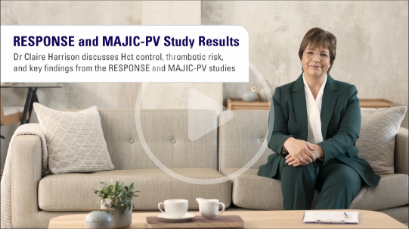When PV advances beyond what HU can control, intervene with Jakafi® (ruxolitinib)
In the phase 3 RESPONSE* trial, Jakafi demonstrated superior results† vs BAT1‡
Kaplan-Meier estimate: durability of primary response at 5 years

The median duration of primary response was not reached.2
Reprinted from The Lancet Haematology, Vol 7, Kiladjian J-J, Zachee P, Hino M, et al, Long-term efficacy and safety of ruxolitinib versus best available therapy in polycythaemia vera (RESPONSE): 5-year follow up of a phase 3 study, e226-e237, Copyright 2020, with permission from Elsevier.
- Analysis was conducted in week 32 primary responders, beginning at week 322
- Progression was defined as: the first of 2 consecutive Hct assessments that confirmed phlebotomy eligibility, a spleen volume assessment that was reduced by <35% from the baseline AND that was ≥25% increased at the time of the best-documented spleen volume response, death, or development of MF or acute leukemia3


For me, even 45.1% isn’t good enough and any hematocrit level above 45% needs action. I believe the time that my patient spends with hematocrit above 45% and every time they need a phlebotomy, or a dose increase in hydroxyurea, that’s the same amount of time they potentially spend at risk of a thrombotic event.
HEAR FROM DR HARRISON ABOUT HCT CONTROL AND THROMBOSIS-FREE SURVIVALIndividual component of the primary endpoint
More patients achieved Hct control with Jakafi in the absence of phlebotomy eligibility
In the RESPONSE trial, patients on Jakafi achieved a higher rate of Hct control vs BAT1
- To achieve the Hct control endpoint, patients could not become eligible for phlebotomy between weeks 8 and 32. Phlebotomy eligibility was defined as Hct >45% that is ≥3 percentage points higher than baseline or Hct >48% (lower value)1,4
Kaplan-Meier estimate: durability of Hct control at 5 years
aAbsence of phlebotomy eligibility.

Reprinted from The Lancet Haematology, Vol 7, Kiladjian J-J, Zachee P, Hino M, et al, Long-term efficacy and safety of ruxolitinib versus best available therapy in polycythaemia vera (RESPONSE): 5-year follow up of a phase 3 study, e226-e237, Copyright 2020, with permission from Elsevier.
- Analysis was conducted in week 32 Hct control responders, beginning at week 322
- Progression events for the evaluation of duration of absence of phlebotomy eligibility included the first of 2 consecutive Hct assessments that confirmed phlebotomy eligibility, death, or development of MF or acute leukemia3
*The RESPONSE trial was a randomized, open-label, active-controlled phase 3 trial comparing Jakafi with BAT in 222 patients with PV. Patients enrolled in the study had been diagnosed with PV for at least 24 weeks, had an inadequate response to or were intolerant of HU, required phlebotomy for Hct control, and exhibited splenomegaly. All patients were required to demonstrate Hct control between 40% and 45% prior to randomization. After week 32, patients on BAT were able to cross over to Jakafi treatment.1,4
†The composite primary endpoint was defined as Hct control without phlebotomy eligibility and a ≥35% spleen volume reduction as measured by CT or MRI. To achieve the Hct control endpoint, patients could not become eligible for phlebotomy between weeks 8 and 32. Phlebotomy eligibility was defined as Hct >45% that is ≥3 percentage points higher than baseline or Hct >48% (lower value).1,4
‡BAT included HU (60%), interferon/pegylated interferon (12%), anagrelide (7%), pipobroman (2%), lenalidomide/thalidomide (5%), and observation (15%).1
§Jakafi: 95% CI, 0.15-0.32; BAT: 95% CI, 0.00-0.05.1
BAT=best available therapy; CI=confidence interval; CT=computed tomography; Hct=hematocrit; HU=hydroxyurea; MF=myelofibrosis; MRI=magnetic resonance imaging; PV=polycythemia vera; RESPONSE=Randomized study of Efficacy and Safety in POlycythemia vera with JAK iNhibitor ruxolitinib verSus bEst available care; WBC=white blood cell.
References: 1. Jakafi [package insert]. Wilmington, DE: Incyte Corporation. 2. Kiladjian J-J, Zachee P, Hino M, et al. Long-term efficacy and safety of ruxolitinib versus best available therapy in polycythaemia vera (RESPONSE): 5-year follow up of a phase 3 study. Lancet Haematol. 2020;7(3):e226-e237. Supplementary appendix available at: doi:10.1016/S2352-3026(19)30207-8. 3. Data on file. Incyte Corporation. Wilmington, DE. 4. Vannucchi AM, Kiladjian JJ, Griesshammer M, et al. Ruxolitinib versus standard therapy for the treatment of polycythemia vera. N Engl J Med. 2015;372(5):426-435. Supplementary appendix available at: https://www.nejm.org/doi/suppl/10.1056/NEJMoa1409002/suppl_file/nejmoa1409002_appendix.pdf.


